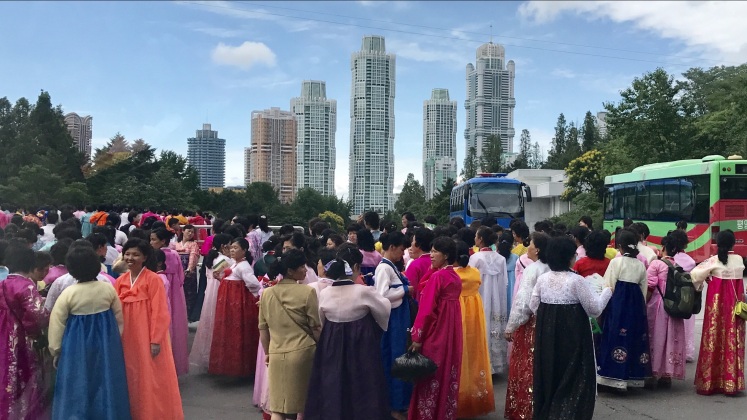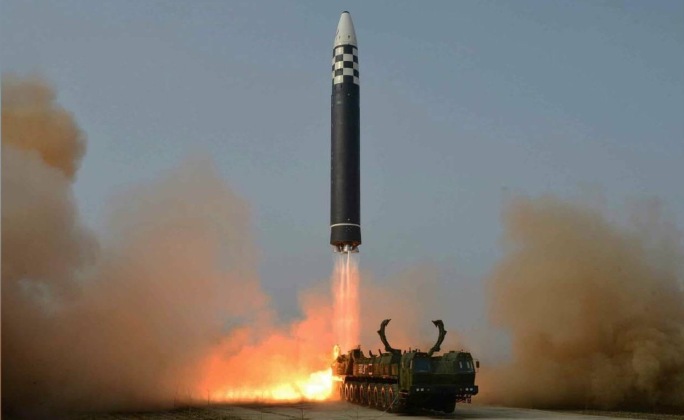Five Years Ago This North Korean Missile Test May Have Saved East Asia From Nuclear War: Why the Hwasong-14 ICBM Matters
July-4th-2022

Nuclear Explosion, Hwasong-14 ICBM, North Korean Soldier
In over 70 years of war between North Korea and the United States, which marks history’s longest ever war between two industrial powers, July 4 2017 marks a key turning point when the former for the first time demonstrated the capability to strike the mainland of the latter by test launching the Hwasong-14 intercontinental range ballistic missile.
In over 70 years of war between North Korea and the United States, which marks history’s longest ever war between two industrial powers, July 4 2017 marks a key turning point when the former for the first time demonstrated the capability to strike the mainland of the latter by test launching the Hwasong-14 intercontinental range ballistic missile.
Where during the Korean War the United States had been able to bombard North Korean cities with impunity, levelling all buildings over two stories and dousing population centres from end to end with napalm, North Korea’s inability to retaliate proportionally had significantly weakened both its strategic position and its position at the negotiating table and allowed Washington to press for more concessions while continuing to rain fire on Korean cities, towns and villages.
With the White House having seriously considered launching nuclear attacks on North Korean targets, both during the war and on multiple occasions afterwards most notably under the Richard Nixon administration in 1969, the fact that the country deployed nuclear weapons to the Korean Peninsula from 1958 had only left North Korea more vulnerable with up to 950 land based warheads having been pointed at its territory.


Hwasong-14 ICBM on Parade
The year 2017 marked a culmination of over 25 years of research and development on miniaturised nuclear warheads and long range ballistic missiles, with North Korea having fielded its first strategic ballistic missile the Rodong-1 from 1993 capable of striking American military facilities across Japan, and thought to have had a small nuclear weapons capability from around the same time.
The year 2017 marked a culmination of over 25 years of research and development on miniaturised nuclear warheads and long range ballistic missiles, with North Korea having fielded its first strategic ballistic missile the Rodong-1 from 1993 capable of striking American military facilities across Japan, and thought to have had a small nuclear weapons capability from around the same time.
These capabilities gradually matured with 2017 seeing tests of the Hwasong-12 ‘Guam Killer’ capable of striking key American military facilities across much of the Pacific, as well as miniaturised thermonuclear warheads which U.S. intelligence would conclude could be integrated onto ballistic missiles.
The Hwasong-14, however represented a pivotal capability because it altered the calculus of any future American attack on its small East Asian adversary. While a full scale assault by the U.S. Military to capture and occupy Pyongyang was projected to entail the deaths of hundreds of thousands if not millions of South Korean, Japanese and Chinese citizens, it had continued to be strongly advocated by many in the military and civilian leadership.
Senator Lindsey Graham, for one stated that military action in Korea was more feasible as damage would be confined to East Asia, while the U.S. mainland would not be in danger. “It would be terrible, but the war would be over there (in the Asia-Pacific,) it wouldn’t be here. It would be bad for the Korean peninsula. It would be bad for China. It would be bad for Japan. It would be bad for South Korea. It would be the end of North Korea, but what it would not do is hit America,” he had said.


Pyongyang, North Korea, in July 2017
Graham was hardly alone, with Californian Congressman Duncan Hunter stating that American should launch a nuclear attack to make sure North Korea could not develop a nuclear deterrent. Lieutenant Colonel Ralph Peters made a similar argument in an opinion piece for the New York Post titled: 'The moral answer to North Korea’s threats, Take them out!' in which he stated the imperative of prioritising the protection of the U.S. mainland and U.S. citizens above all else – even if that meant causing a devastating war in East Asia.
Graham was hardly alone, with Californian Congressman Duncan Hunter stating that American should launch a nuclear attack to make sure North Korea could not develop a nuclear deterrent. Lieutenant Colonel Ralph Peters made a similar argument in an opinion piece for the New York Post titled: 'The moral answer to North Korea’s threats, Take them out!' in which he stated the imperative of prioritising the protection of the U.S. mainland and U.S. citizens above all else – even if that meant causing a devastating war in East Asia.
“The fundamental reason our government exists is to protect our people and our territory. Everything else is a grace note. And the words we never should hear in regard to North Korea’s nuclear threats are, ‘We should’ve done something,’” he said.
President Donald Trump’s national security adviser H. R. McMaster similarly said that even if U.S. military action which would guarantee a “human catastrophe” in South Korea was the price that needed to be paid, it was still vital to take action to prevent North Korea from gaining a nuclear deterrent which could reach the U.S. mainland. Chairman of the Joint Chiefs of Staff Joseph Dunford was among those who came to a similar conclusion.

Demonstrating an ICBM capability was particularly important in 2017, since the Barak Obama administration had the previous year come very close to launching limited strikes on North Korea while the Trump administration in 2017 considered nuclear attacks that were set to “incinerate a couple of million people” across the country.

Demonstrating an ICBM capability was particularly important in 2017, since the Barak Obama administration had the previous year come very close to launching limited strikes on North Korea while the Trump administration in 2017 considered nuclear attacks that were set to “incinerate a couple of million people” across the country.
The Hwasong-14 was a game changer, and while U.S. Ambassador to the United Nations Nikki Hayley had previously stated that North Korea was "begging for war,” with the initiation of a major East Asian conflict by Washington appearing a considerably possibility, gaining the ability to strike the United States mainland ensure that a war 'over there’ in which America would be beyond reach was no longer an option.
North Korea would subsequently launch another Hwasong-14 test successfully on July 28 and the much larger Hwasong-15 in November, which was capable of striking the East Coast including New York City, before pursuing a detente with Washington from a stronger position and subsequently working on modernising its shorter ranged tactical missile assets.
With a breakthrough with Washington and end to the war failing to materialise, North Korea unveiled a new ICBM, the Hwasong-17, in 2020 which it would test in March 2022 and possibly again in May, as well as the shorter ranged hypersonic glide vehicle equipped Hwasong-8 which made it only the third country in the world with such an asset.
The ICBM deterrent has entirely transformed the discourse in the Washington regarding initiating a war against North Korea, which has been key to ensuring the security not only of North Korea’s population but also to those of neighbouring countries which U.S. officials were otherwise willing to consider placing in the firing line to subdue America's oldest state adversary.
If North Korea ever uses the Hwasong-14 against US soil, the result will be the most complex surviving form of life in North Korea will be genus Periplaneta.
ReplyDelete“The fundamental reason our government (USofA) exists is to protect our people and our territory. Everything else is a grace note"
ReplyDelete'The moral answer to North Korea’s threats, Take them out!'
Ha!
So arrogant! Only USofA matters. Nothing else should get into his way devil &/or otherwise!
Who would strike first with a nuke is that question u, as a spiritual yank, would NEVER contemplate.
Historical rhetorics of the Yankee Hawks have proven time & again that Yankee doodle would be the most likely candidate to INITIATE a nuclear war.
So DON'T u worry about what would still exist on the NKorea soil when a nuke strikes. U should worry about what would remain in yr spiritual holyland of Yankee soil.